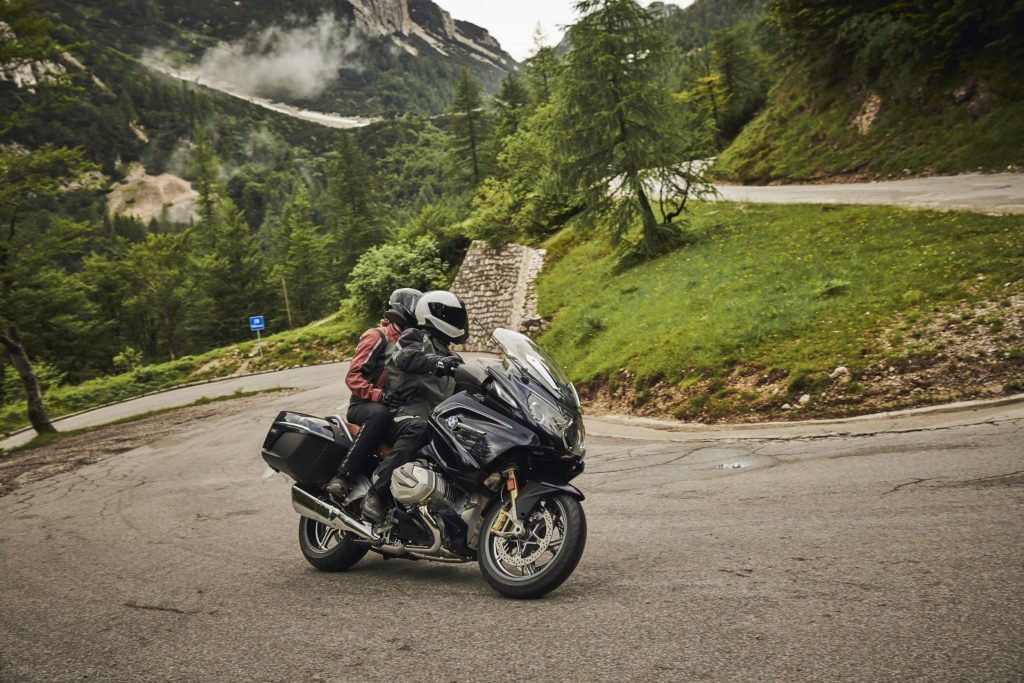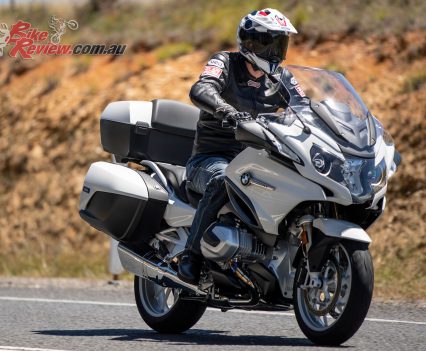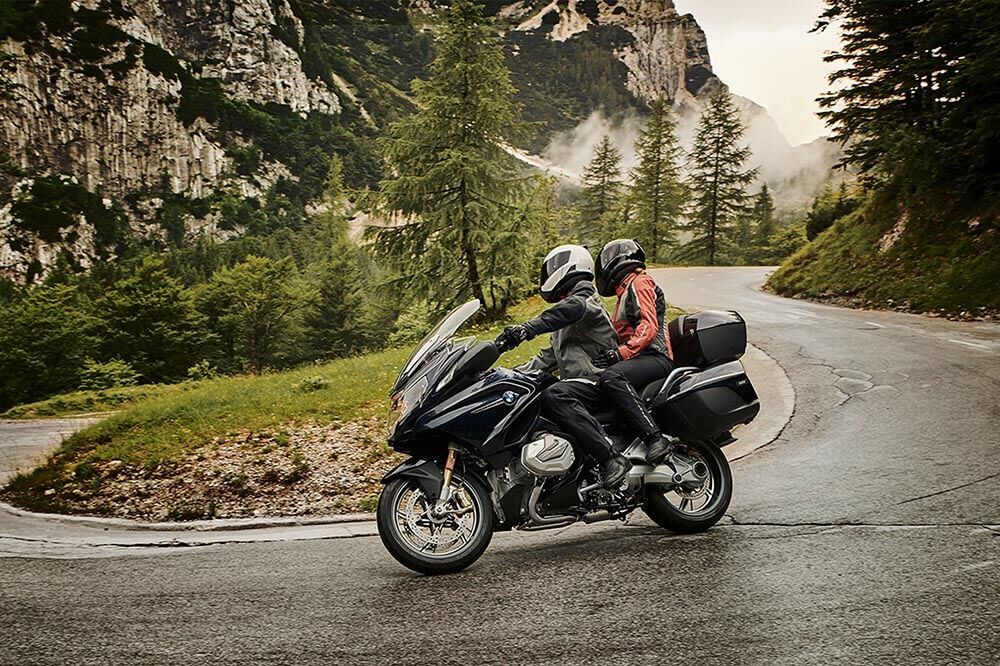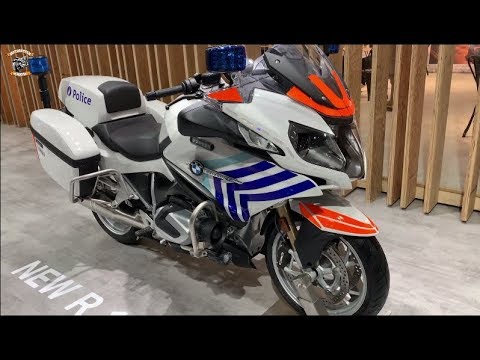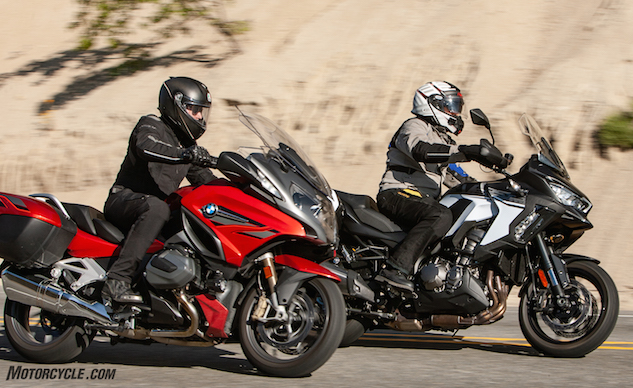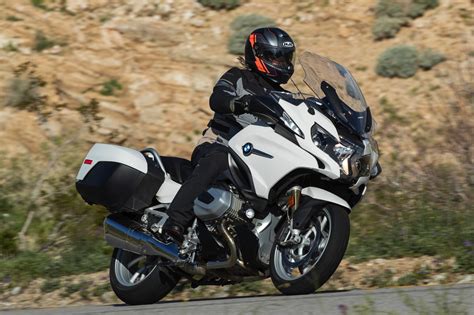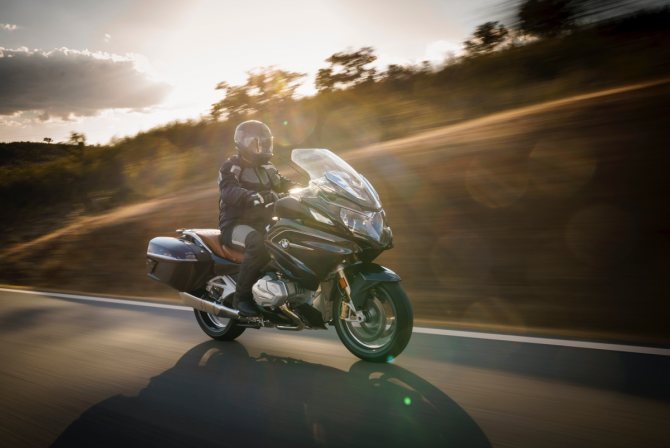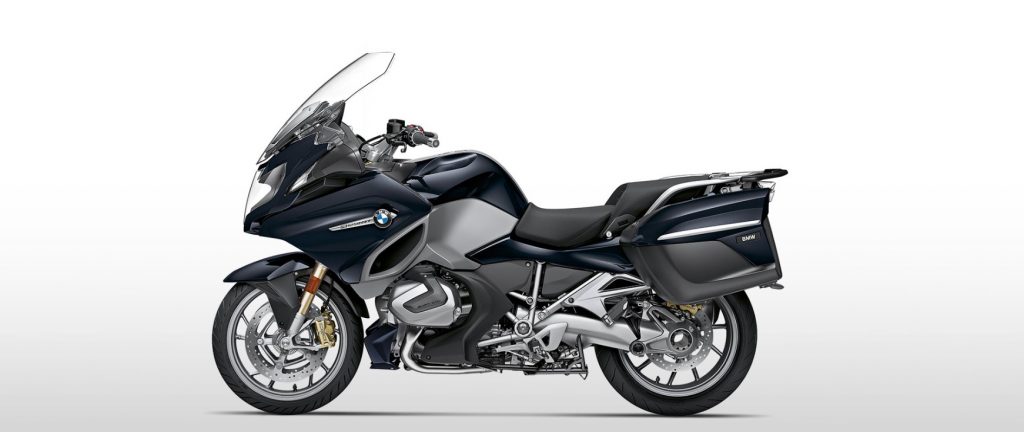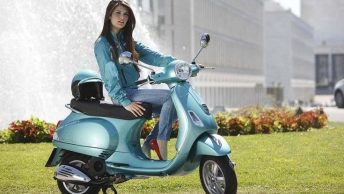BMW R 1250 RT Drivetrain
- 1,254 cc flat-twin engine
- 136 horsepower and 105 lb-ft of torque
- Automatic stability control
- Broader powerband
The factory took its 1,170 cc boxer engine and punched it out to a total of 1,254 cc for this newest iteration, and that necessarily brings more power to the table to the tune of 136 horsepower (up from 125 ponies) and 105 pound-feet of torque (up from 92 pounds o’ grunt). This puts the RT squarely in the power-tour category, and is sure to endear itself to riders who are looking for a tourbike that comes with a bit of testicular fortitude.
The flat-twin engine runs a counter-balancer so as to tune the worst of the vibrations out of the system, so numb hands and bottoms do not come standard. Compression is pretty spicy at 12.5-to-1, so you can go ahead and resign yourself to running top-dollar road champagne through the electronic throttle bodies. Engine control is modified by the Automatic Stability Control that most of us will identify as traction control, but they can call it whatever they like; it does the same job.
It’s cooled primarily by air, but similar to Harley’s Twin-Cooled technology, the mill circulates coolant through the heads to draw heat away from the hottest spots. Inside, oil jets perform the same function to cool the piston crowns from beneath, but that’s not the best part. A variable timing system advances and retards the cam timing to broaden the powerband, and the intake valves run with an asynchronous timing feature designed to cultivate more swirl in the air-fuel mixture as it enters the combustion chamber for better vaporization and flame-front propagation. Nifty stuff, yeah? I certainly thought so.
The factory claims a top speed of (over) 125 mph, not that you’ll ever be able to use all that potential on our side of the pond, not legally anyway. Still, it’s comforting to know you’ve got plenty of roll-on left to make decisive passes and get out of the way of the oblivious cagers around you.
| Engine: | Air/liquid-cooled 4-stroke flat twin engine, double overhead camshaft, one balance shaft and variable engine timing system BMW ShiftCam |
|---|---|
| Bore x Stroke: | 102.5 mm x 76 mm |
| Displacement: | 1,254 cc |
| Rated output: | 136 hp (100 kW) at 7,750 rpm |
| Max. torque: | 105 lb-ft (143 Nm) at 6,500 rpm |
| Compression ratio: | 12.5 : 1 |
| Mixture control / engine management: | Electronic fuel injection with ride-by-wire throttle system |
| Emission control: | Closed-loop 3-way catalytic converter, emission standard EU-4 |
| Clutch: | Multiplate wet clutch, hydraulically operated |
| Gearbox: | Constant-mesh 6-speed gearbox with helical cut gears |
| Drive: | Shaft drive |
BMW R 1250 RT Pricing
Buyers can expect an MSRP of $18,645, if they can keep out of the accessories catalog. Good luck with that. The 2020 R 1250 RT can be had in a handful of color packages that include Manhattan Metallic, Alpine White, two-tone colorways Mars Red Metallic / Dark Slate Metallic Matte or Blue Planet Metallic/Ivory, and a Sparkling Bronze Metallic if you opt for the Spezial Option 719 billet package that offers even more customization options.
| Standard Equipment: | 2 Ride Modes (Rain/Road), ABS Pro, Adjustable Gear Shifter, Adjustable Two-Section Seat, ASC (Automatic Stability Control), Heated Grips, Hill Start Control, LED Tail Light, LED Turn Signals, Multi Controller, On-Board Computer Pro, Saddle Bags in Body Color, ShiftCam (Variable Camshaft Control), Steering Damper, Stepless Power Adjustable Windshield, Storage Compartment, Toolkit |
| Colors: | |
| └ 2019: | Carbon Black Metallic, Mars Red Metallic/Dark Slate Metallic Matte, Alpine White, Opt 719 Blue Planet Metallic, Opt 719 Sparkling Storm Metallic |
| └ 2020: | Manhattan Metallic, Mars Red Metallic / Dark Slate Metallic Matte, Alpine White, Blue Planet Metallic/Ivory, Opt 719 Sparkling Bronze Metallic |
| Price: | $18,645 |
BMW R 1250 RT Chassis
- Optional electronic suspension
- Hill Start control
- ABS Pro
- Sportbike-type handling
The frame on the R 1250 RT is all but completely hidden by the bodywork, and the result is a clean- and finished-looking assembly. It runs a bolt-on subframe section, and uses the engine as a stressed member to complete the circuit and eliminate a significant portion of the tubing with obvious benefits to the overall weight.
Out back, a cast-aluminum, single-side swingarm articulates the rear wheel and doubles as a housing for the final-drive shaft for some supremely clean running gear. The steering head has a damper as part of the standard equipment, and it kicks the inverted Telelever forks out to 25.9-degrees from the vertical with 4.56-inches of trail. Them’s some pretty agile numbers folks, and it definitely favors sport-type handling that’s eager in the corners, though the tradeoff comes at the expense of tracking, especially in a crosswind and when making passes.
The stock suspension runs non-adjustable stems up front with adjustable preload and rebound-damping out back, both of which come with handwheel adjusters for quick and easy tweaks sans tools. Beemer’s Dynamic ESA is a gear package that delivers full-spectrum adjustments automatically, but it’s optional equipment that doesn’t make it onto the standard machine in an effort to keep costs down, no doubt.
The ABS Pro feature does its bit to preserve contact-patch integrity under emergency braking and keep you dirty-side down, and it works with the dual 320 mm discs and four-pot calipers up front and the 276 mm rear disc and twin-piston anchor out back. Cast-aluminum wheels round out the rolling chassis with a symmetrical, 17-inch diameter front and rear that mounts a 120/70 and 180/55, respectively.
| Frame: | Two section frame, front – and bolted on rear frame, load bearing engine |
|---|---|
| Front suspension/Travel: | BMW Telelever, Ø 37 mm, central spring strut/4.7″ (120 mm) |
| Rear suspension/Travel: | Cast aluminum single-sided swing arm with BMW Paralever; WAD strut (travel-related damping), spring pre-load hydraulically adjustable (continuously variable) via handwheel, rebound damping adjustable via handwheel/ 5.4″ (136 mm) |
| Castor: | 4.6″ (116 mm) |
| Steering head angle: | 25.9° |
| Wheels: | Cast aluminum wheels |
| Rims, front/rear: | 3.50’’ x 17’’ / 5.50’’ x 17’’ |
| Tire, front: | 120/70 ZR 17 |
| Tire, rear: | 180/55 ZR 17 |
| Brake, front: | Dual floating disc brakes, 4-piston fixed calipers, diameter 320 mm |
| Brake, rear: | Single disc brake, diameter 276 mm, dual-piston floating caliper |
| ABS: | BMW Motorrad Integral ABS (part-integral) |
BMW R 1250 RT Specifications
| Engine & Drivetrain: | |
|---|---|
| Engine: | Air/liquid-cooled 4-stroke flat twin engine, double overhead camshaft, one balance shaft and variable engine timing system BMW ShiftCam |
| Bore x Stroke: | 102.5 mm x 76 mm |
| Displacement: | 1,254 cc |
| Rated output: | 136 hp (100 kW) at 7,750 rpm |
| Max. torque: | 105 lb-ft (143 Nm) at 6,500 rpm |
| Compression ratio: | 12.5 : 1 |
| Mixture control / engine management: | Electronic fuel injection with ride-by-wire throttle system |
| Emission control: | Closed-loop 3-way catalytic converter, emission standard EU-4 |
| Clutch: | Multiplate wet clutch, hydraulically operated |
| Gearbox: | Constant-mesh 6-speed gearbox with helical cut gears |
| Drive: | Shaft drive |
| Chassis: | |
| Frame: | Two section frame, front – and bolted on rear frame, load bearing engine |
| Front suspension/Travel: | BMW Telelever, Ø 37 mm, central spring strut/4.7″ (120 mm) |
| Rear suspension/Travel: | Cast aluminum single-sided swing arm with BMW Paralever; WAD strut (travel-related damping), spring pre-load hydraulically adjustable (continuously variable) via handwheel, rebound damping adjustable via handwheel/ 5.4″ (136 mm) |
| Castor: | 4.6″ (116 mm) |
| Steering head angle: | 25.9° |
| Wheels: | Cast aluminum wheels |
| Rims, front/rear: | 3.50’’ x 17’’ / 5.50’’ x 17’’ |
| Tire, front: | 120/70 ZR 17 |
| Tire, rear: | 180/55 ZR 17 |
| Brake, front: | Dual floating disc brakes, 4-piston fixed calipers, diameter 320 mm |
| Brake, rear: | Single disc brake, diameter 276 mm, dual-piston floating caliper |
| ABS: | BMW Motorrad Integral ABS (part-integral) |
| Dimensions & Capacities: | |
| Length: | 87.5″ (2,222 mm) |
| Width (incl. mirrors): | 38.8″ (985 mm) / 39″ (990 mm) incl. panniers |
| Height (excl. mirrors): | Standard: 55.3″ (1,405 mm) , Style Sport: 53.5″ (1,360 mm) |
| Wheelbase: | 58.5″ (1,485 mm) |
| Seat height, unladen weight: | Standard: 31.7″/32.5″ |
| Optional Seat Height: | High Seat: 32.7ʺ/33.5ʺ, Low Seat: 29.9ʺ/30.7ʺ |
| Inner leg curve, unladen weight: | High Seat: 73.8″/75.4″, Standard: 71.3″/72.8″, Low Seat: 68.5″/70.1″ |
| Unladen weight, road ready, fully fueled: | 615 lbs (279 kg) 1) |
| Permitted total weight: | 1,113 lbs (505 kg) |
| Payload (with standard equipment): | 498 lbs (226 kg) |
| Usable tank volume: | 6.6 gal (25 L) (Reserve: Approx. 1 gal (4 L)) |
| Fuel consumption: | 50 mpg (WMTC) |
| Fuel type: | Premium Unleaded |
| Maximum speed: | Over 125 mph |
| Electricals: | |
| Alternator: | Three-phase 508 W generator |
| Battery: | 12 V / 12 Ah, maintenance-free |
| Details: | |
| Standard Equipment: | 2 Ride Modes (Rain/Road), ABS Pro, Adjustable Gear Shifter, Adjustable Two-Section Seat, ASC (Automatic Stability Control), Heated Grips, Hill Start Control, LED Tail Light, LED Turn Signals, Multi Controller, On-Board Computer Pro, Saddle Bags in Body Color, ShiftCam (Variable Camshaft Control), Steering Damper, Stepless Power Adjustable Windshield, Storage Compartment, Toolkit |
| Colors: | |
| 2019: | Carbon Black Metallic, Mars Red Metallic/Dark Slate Metallic Matte, Alpine White, Opt 719 Blue Planet Metallic, Opt 719 Sparkling Storm Metallic |
| 2020: | Manhatten Metallic, Mars Red Metallic / Dark Slate Metallic Matte, Alpine White, Blue Planet Metallic/Ivory, Opt 719 Sparkling Bronze Metallic |
| Price: | $18,645 |
BMW R 1250 RT Design
- Push button-adjustable windshield
- Full color 5.7-inch TFT display
- Narrow waist
- Sportbike styling
Play
The new BMW R 1250 RT
by BMW Motorrad
You can tell at a glance that the R 1250 RT saw the inside of a windtunnel during its conception. A low-profile front fender leads the way ahead of a sportbike-like cowl scoop and low-resistance/high-penetration front fairing. As broad as the forward bodywork is, the visage is dominated by a trio of recessed light cans that boast stock halogen projectors, but you’ll have to hit the accessories catalog if you fancy the LED daytime running lights. A pity, that, but the Werke has a tendency to shuffle items between the advanced packages as well as between the optional gear and stock, so maybe next year? We’ll see.
Up top, a mid-size, pushbutton-adjustable windshield breaks the pressure on your chest but lets the incoming wind strike your helmet to make your vents breathe as intended . The vented design smooths out the margin between pocket and slipstream for a low-buffet riding experience. Winglets on the fairing work with the mirrors mounted in the tips to protect your meathooks, and you can pencil me in as a fan, ’cause anything is better than stem-mount mirrors in my estimation. Like the headlights, the front turn signals are recessed and faired off with clear lenses, and that just keeps the front end clean as a whistle.
Inside the fairing, a pair of analog gauges display speed and revs with a whole battery of indicator lights and a digital display in betwixt to cover the remaining metrics. Additionally, a full-color, 5.7-inch TFT screen is part of the standard package, and it acts as a rider-to-bike interface for the higher electronic features such as mobile phone and media playback, to name a few.
A voluminous, 6.6-gallon fuel tank defines the flyline in a most sport-tastic fashion with a generous knee pocket and upper flange for good aerodynamics, but it quickly wanes toward the rear to make for a narrow waist and a comfortable union. Yeah, nothing worse than feeling like you’re gripping the barrel of a horse, right? Especially when you go to deploy your Fred Flintstones. The adjustable beveled seat contributes to that as well, before it flares out to form a comfortable butt bucket. Stadium seating greets your passenger with flip-out footpegs and large grabrails that make up points-of-contact one through four.
So many manufacturers outside the U.S. seem to think a bike without stock bags qualifies as a tour bike, but I can assure you, Americans do not share that opinion. Maybe if they had somewhere to ride in their country that’s bigger than a postage stamp they’d get it right, but instead here we are. Beemer got it right on the RT, though. A pair of stock hard-side panniers provide enough storage for some serious travel, and you can tell at a glance they came under the scrutiny of the windtunnel testers. Of course, you can boost that capacity with a topcase ex werke.
LED emitters cover the rearward lighting to make you as visible coming as you are going (no giggety) to finish the RT off. (still no giggety)
BMW R 1250 RT Competitors
Due to design considerations, I expect challengers to the R 1250 RT to come from elsewhere and Japan seemed like a good place to start. Kawasaki was my Huckleberry this time around with its
Concours 14 ABS that rocks a similarly sport-tastic look with performance to match, so let’s get started.
Kawasaki Concours 14
The Kawi’s look is defined by the ribs in the cowling vents that are more or less duplicated by the stiffeners in the hard-side panniers for a nice continuity of design. Wind-swept body panels close off much of the Concours to give the impression of low-resistance penetration, and like the Beemer, the vented windshield is electrically adjustable for adjustments on the fly. You can’t tell it at a glance, but the Concours relies on a monocoque or stressed-skin structure to provide the support instead of using a skeletal assembly like the RT. Not sayin’ it’s better, just sayin’ it is what it is.
The stock Concours rocks adjustable suspension goodies at both ends with rebound-damping and preload adjustments on the menu, and Kawi toes the sport-bike line with symmetrical 17-inch wheels front and back that come complete with ZR-rated tires showing this bike means serious business. Kawi’s ABS comes augmented with its Advanced Coactive-braking feature that shares pressure between the front and rear binders for a little bit of lagniappe and extra security.
In the power department, Kawi doesn’t disappoint. The heart of a Ninja beats in the aluminum chest, and it rocks variable cam-timing as well to meet Beemer partway, at least. Torque measures in at 100.5 pound-feet; barely enough to qualify it as a power-tourer, but enough all the same even if it falls a smidge short of the RT’s 105-pounds o’ grunt.
With the Concours, you get a variable cam-timing feature that deepens the torque well a bit, but Kawi stops short of the absolute fandanglery Beemer brings to the table. That shortcoming, of course, is reflected in the price. Kawi lets loose of a Concours 14 ABS for $15,599, and that may be enough to tipple someone who is riding the fence.
Read our full review of the Kawasaki Concours 14.







